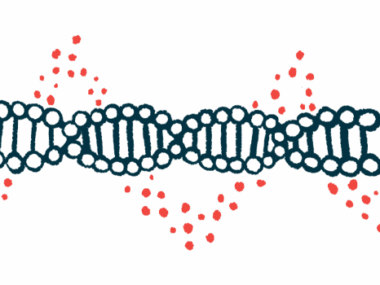Gene Profiling Reveals SSc-ILD Patients Who Respond Best to CellCept
Written by |

Gene activity profiles in blood cells isolated from systemic sclerosis patients with interstitial lung disease predicted lung function responses to the immunosuppressant therapy CellCept (mycophenolate mofetil), a study has shown.
These findings support the use of non-invasive gene profiling to identify patients who will best respond to CellCept and to improve future personalized treatments, according to researchers.
The study, “Peripheral blood gene expression profiling shows predictive significance for response to mycophenolate in systemic sclerosis-related interstitial lung disease,” was published in the Annals of the Rheumatic Diseases.
Interstitial lung disease (ILD) is the leading cause of death in people with systemic scleroderma, also called systemic sclerosis (SSc). ILD is a group of lung conditions characterized by inflammation and scarring (fibrosis) of the tissue in and around the air sacs in the lungs, which impairs breathing.
CellCept and cyclophosphamide (sold under the brand name Cytoxan, among others) are two common medications that improve lung function in SSc-ILD patients by suppressing the inflammatory immune response associated with SSc.
Studies indicate that response to these immunosuppressive therapies is highly variable in SSc-ILD, with about one-third of patients experiencing lung function decline despite treatment. Furthermore, these medications can cause serious side effects, emphasizing the need to identify likely responders using predictive biomarkers.
Analysis of gene expression, or activity, within peripheral blood cells (PBCs) is a non-invasive method to monitor molecule changes in response to treatments. These data can act as predictive biomarkers but can also be helpful for clinical trials in SSc.
However, studies investigating the effects of CellCept and Cytoxan on gene expression in PBCs are limited.
In this report, researchers at the University of Texas Health Science Center sought to characterize PBC gene expression changes caused by treatment with CellCept or Cytoxan and determine the ability of this approach to predict therapeutic responses.
The team analyzed PBC gene expression profiles from blood samples collected during the Scleroderma Lung Studies II (SLS II) study (NCT00883129), which compared the effects of oral CellCept to oral Cytoxan on lung function and health-related symptoms in people with SSc-ILD. Expression profiles were examined before treatment (baseline) then compared to those observed every three months up to one year.
Baseline data were available for 65 trial participants assigned CellCept and 69 given Cytoxan, while one-year data included samples from 51 CellCept-treated patients and 47 who received Cytoxan. Overall, the mean disease duration was 2.6 years, and 59% of participants had diffuse skin involvement.
Results revealed that treatment with Cytoxan led to substantial changes in the PBC gene expression profile, including in 6,873 genes that were expressed differently after treatment compared with baseline. In comparison, CellCept changed the expression of 113 genes after one year.
Expression profiles were grouped into modules, or a set of genes expressed differently at the same time. Then, composite scores were calculated for each module and compared with baseline clinical characteristics, including disease duration, disease type, skin involvement, lung function, and other established SSc biomarkers.
Statistical analyses showed that none of the baseline gene expression module scores correlated with baseline disease characteristics. In addition, baseline scores did not predict the course of skin involvement, as assessed by the modified Rodnan Skin Score during the three-month to one-year follow visits in any of the treatment groups.
In patients treated with Cytoxan, none of the baseline gene expression scores significantly predicted the course of lung function, as measured by forced vital capacity (FVC) — the total amount of air a person is able to exhale after one breath.
However, in CellCept-treated patients, expression differences at baseline in lymphoid cells — such as immune T-cells and natural killer cells — and modules related to energy-producing mitochondria and protein production significantly predicted lung function improvements with CellCept. Expression changes related to myeloid cells at baseline, such as immune neutrophils or granulocytes, predicted decline in lung function.
A one-unit increase in baseline lymphoid module score was associated with a 2.85% improvement in FVC during the three-month to one-year visits.
In another analysis, the team compared the expression profiles of 52 patients whose lung function improved with CellCept, as defined by an increase in FVC of more than 3%, to 64 who did not improve. Consistently, participants with higher lymphoid and mitochondrial module scores were more likely to show FVC improvement, while those with higher scores related to myeloid cells and inflammation were less likely to experience an improvement in lung function.
Here, with CellCept treatment, every one-unit increase in baseline lymphoid module score was associated with a 3.6-times higher likelihood of lung function improvement.
In an analysis of FVC worsening, the researchers compared the gene expression profiles of 26 patients whose lung function declined after treatment with CellCept, defined by a decrease in FVC of more than 3%, to 90 who were categorized as non-decliners. Again, higher myeloid and inflammation module scores predicted worse lung function, while higher lymphoid, T-cell, and mitochondrial module scores were associated with a lower likelihood of FVC decline.
“The baseline PBC immune modules showed predictive significance for the course of SSc-ILD in the [CellCept] arm,” the researchers wrote. “With the emergence and development of novel therapeutics for SSc-ILD, gene expression profiling may improve our ability to personalize treatment for patients in the future.”







